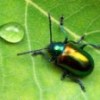
Tenebrio molitor, pupa
Tenebrio molitor is a darkling beetle known more for its immature stages than for its adults. It is the ubiquitous mealworm. You can buy these granivorous beetles at any pet store as food for fish, birds, and reptiles.
The above shot of a developing pupa requires two sources of light. A flash head positioned behind the insect backlights the subject to produce the translucent glow. A second, positioned above and in front, is powered down and provides the highlights and details of the head and appendages.

Tenebrio molitor larva and pupa

Stronger backlighting gives this shot more glow
Photo details: Canon MP-E 65mm 1-5x macro lens on a Canon EOS 50D
ISO 100, f13, 1/40-1/250Â sec
More like this
Acoustic Phenomena Explain Why Boats And Animals Collide:

I love your blog. I get to learn not just about insects but also photography/lighting at the same time!
very beautiful
Thanks, Kurt! That's very kind of you to say so.
The craftsmanship of photography really becomes apparent in this entry. Each image is spectacular. Maybe you should speak with the university about offering a biological photography class in addition to the beekeeping class this summer. Alternatively, you could offer a photography class for educators broadly across the K-16 spectrum.
In the wake of the recent financial recissions and the university-wide focus on rising in rankings as well as uniqueness of programming I think one of our gems remains undiscovered...
Thanks Dave! We're on it. Andy Suarez and I are planning an Insect Photography discovery class for the fall, although we're still waiting for University approval. With any luck the budget cuts won't torpedo the idea.
Awesome. Are you using extenders for the ring flash heads or a different strobe unit?
I've got the camera on a tripod. My hands are then freed to move the MT-24EX flash heads about as needed.
Then you press the shutter release with your third hand? :)
That does it - I've got to get a tripod.
I'm well familiar with these guys, as I breed them for my reptiles and spiders.
I've always thought the pupae were nifty looking, but you make them darned glamorous.
Really enjoying these segments for both the images and the education. Rock on.
Ahh, they're so cute at that age!
Ted,
Check these out:
http://www.patersonphotographic.com/benbo-tripods.htm
Best thing since sliced bread for natural light macro work. Bit fiddly as a regular tripod, but they are so versatile I put up with it.
That first shot is a cracker; the details in the developing exoskeleton are superb.
Something about it reminds me of the film Alien...
Would you suggest the Benbo Mini Trekker?
I use the regular Trekker, because I wanted the height for taking straight down photos of quadrats. Not seen the mini, so can't really comment.
Found a review of a uni-loc, which is a different brand of basically the same product.
http://forums.dpreview.com/forums/read.asp?forum=1034&message=11688125
Loved his comment "like teaching a drunken octopus to play bagpipes"!!
I forgot to ask - do you need a snoot to point the light at the back of the pupa, to prevent light spill and glare in the image?
I have totally zero experience with more than one artificial light sources. Thanks :)
Hummm. Evidently the totally unknown (to me) critter I found in the soil this afternoon might be some kind of beetle pupa.
Awesome photos!